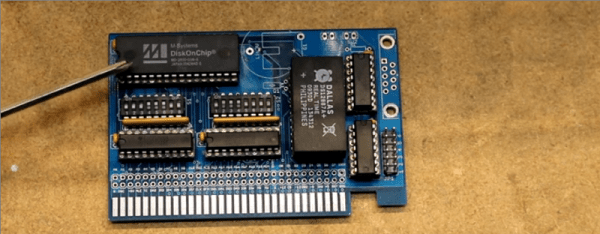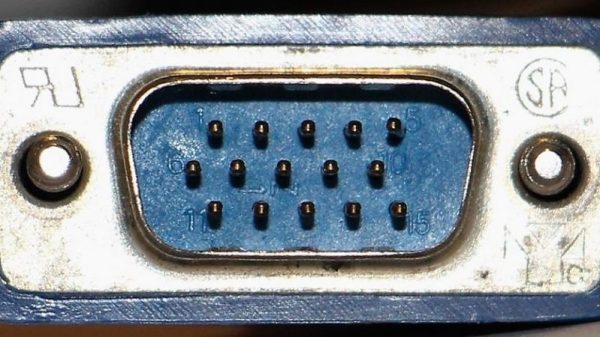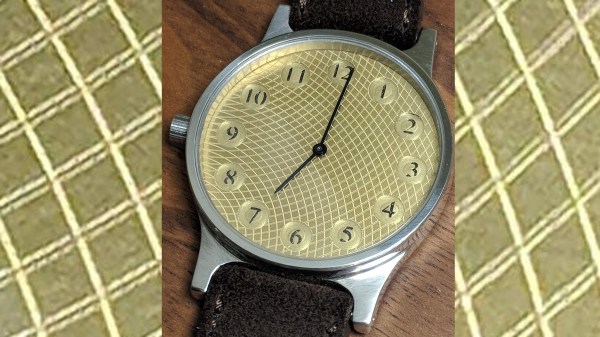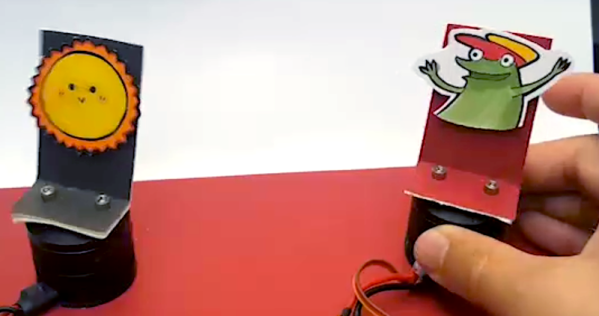Sorting Mms by Color Funny Quots

There have been a lot of different mass storage methods over the relatively short lifespan of the computer. Magnetic tapes, drums, all sorts of disks, and flash memory have each had their time. Each of these new innovations required some time to become easy to use. One of the early attempts to simplify using flash memory was the M-Systems DiskOnChip device. Looking like a standard 8K JEDEC-compatible memory device, it actually provided access to a flash disk drive ranging from 16MB to 1GB. [Smbakeryt] bought some of these devices and built an ISA board to provide a disk and clock for the old 8-bit bus. You can see a video discussion about the device below.
SanDisk bought M-Systems and discontinued the devices back in 2007. Of course, you can still design flash memory into your system, but the simple and efficient interface of the DiskOnChip is no more. It is a testament to how simple the interface is that the schematic for the little board fits on a page, including the DS12885 real time clock.
Continue reading "A Retrocomputer Disk On A Chip"

Did you ever wonder what your monitor and your computer are talking about behind your back? As it turns out, there's quite a conversation going on while the monitor and the computer decide how to get along, and sniffing out VGA communications can reveal some pretty fascinating stuff about the I²C protocol.
To reverse engineer the configuration information exchanged between a VGA monitor and a video card, [Ken Shirriff] began by lopping a VGA cable in two. The inside of such cables is surprisingly complex, with separate shielding wires for each color and sync channel and a host of control wires, all bundled in multiple layers of shielding foil and braid to reduce EMI. [Ken] identified the clock and data lines used for the I²C interface and broke those out into a PocketBeagle for analysis using the tiny Linux machine's I²C tools.
With a Python script to help decode the monitor's Extended Display Identification Data (EDID) data, [Ken] was able to see everything the monitor knows about itself — manufacturer, serial number, all the supported resolution modes, and even deprecated timing and signal information left over from the days when CRTs ruled the desktop. Particularly interesting are the surprisingly limited capabilities of a VGA display in terms of color reproduction, as well as [Ken]'s detailed discussion on the I²C bus in general and how it works.
We always enjoy these looks under the hood that [Ken] is so good at, and we look forward to his reverse engineering write-ups. His recent efforts include a look at core memory from a 50-year old mainframe and reverse engineering at the silicon level.

Some people love Forth and some people hate it. However, you usually think of Forth as something running on a little computer such as an 8-bit microcomputer. When [Chuck Moore] developed the system back in the 1960s though, it ran on an IBM 1130. [Carl Claunch] took a scanned listing of the original code and got it running once again.
There are actually a few blog posts with details. Luckily, Forth is pretty simple — especially the core parts. However, there are a lot of differences from a modern Forth. The most obvious is that the dot keyword starts a definition and does not print the top of stack. However, internal details are different too — the system, for example, stores characters in packed EBCDIC — an ASCII-like code used by IBM computers.
Continue reading "Forth Version 1 Runs Again"

Sometimes silence is the best compliment to a DIY project, and that doesn't just apply to homemade lockjaw toffee. When a watch is so well-made that it looks like one from a jewelry store, it is easy to keep quiet. [ColinMerkel] took many pictures of his fourth wristwatch attempt but "attempt" is his word because we call this a success. This time around he didn't forget the crown for adjusting the time so all the pieces were in place.
His second "attempt" at wristwatch making was featured here and it had a classical elegance. Here, the proverbial game has been stepped up. Instead of using stock steel, the body is constructed of 303 stainless steel. The watch dial will definitely draw compliments if its DIY nature is revealed, which is equally mathematical and charming. Pictures of this process were enough to convey the build without words which is always a bonus if you only want a quick look or English isn't your first choice for language.
Not only is [Colin] an upstanding horologist, he has a reputation with aftermarket door security and a looping guitar pedal.

We think of motors typically as pretty dumb devices. Depending on the kind, you send them some current or some pulses, and they turn. No problem. Even an RC servo, which has some smarts on board, doesn't have a lot of capability. However, there is a new generation of smart motors out that combine the mechanical motor mechanism with a built-in controller. [Bunnie] looks at one that isn't even called a motor. It is the IQ position module.
Despite the name, these devices are just a brushless DC motor (BLDC) with a controller and an API. There's no gearing, so backdriving the motor is permissible and it can even double as a motion sensor. The video below shows [Bunnie] making one module track the other using just a little bit of code.
Continue reading "IQ Makes Smarter Motors"

The future of 3D printing, it seems, is in multimaterial filament printers. The Prusa I3 multimaterial upgrade exists, and this weekend at MRRF E3D announced their amazing multihead printer. Multimaterial printing will get you mechanical parts with the properties you want, like wheels with grippy treads and strong hubs. It will give you easily removable support material. The most popular use, though, is bound to be multicolor prints. It's easier to do, as you're really only working with either ABS or PLA, and if you're really clever, you can squeeze everything through a single nozzle.
While there are some very ingenious ways of printing in multiple colors of filament, one technique that hasn't gotten a lot of attention is automated filament splicing. With this, a piece of software analyzes a model, and combines multiple spools of filament into one long strand. A machine that's getting a lot of attention is the Palette+ from Mosaic Manufacturing. There were a few of these on hand at this weekend's Midwest RepRap Festival, and here anyone could get a hands-on with this machine without spending $800.
When it comes to multicolor and multimaterial prints, the first question that comes to mind is the toolchain and the process of turning an STL file into a physical object. The Palette+ uses a piece of software called Chroma that takes STL files as its input. Each color in the object to be printed is actually a separate STL file, combined on Chroma's build platform. The Charmander print shown above is actually four different prints; the white eyes are one STL, the orange body is a second, the yellow belly is a third, and the red flame on the tail is a fourth STL. In the Chroma app, these STLs are assembled, colors are assigned, and a file generated that's stored on an SD card and shoved in the Palette robot. The Palette then assembles a custom length of filament with the right colors in the right places. Combine this with some G-code from your favorite slicer, and you have everything you need for multicolor printing with the printer you already own.
The results are fantastic, and the best I've ever seen from a multicolor filament-based printer, whether it's a dual-extrusion head, Prusa's Multimaterial upgrade, or a bizarre machine with multiple toolheads.
Of course, there are downsides. Because the Palette is designed for single-extruder printers, you're not going to be able to combine ABS and PLA filament. Combining fancy engineering plastics and colorful PLA is right out. This is a machine that can only use one type of plastic at a time.
That said, we're getting very, very close to an era of true multicolor printing. Of course, this machine costs as much as a good 3D printer, but if you just want to print some colorful blobs of plastic, I haven't seen anything better.

If you've ever disturbed your partner by getting up during the night and flicking on the bathroom light — or tripping over something and startling them awake completely in the ensuing catastrophe — [Kristjan Berce]'s idea to install motion-activated ground-effect lighting on his girlfriend's bed might hold your attention.
[Berce] is using an Arduino Nano for the project's brain, a PIR sensor from Adafruit, and an L7805 voltage regulator to handle load spikes. He doesn't specify the type of LED strip he's using, but Neopixels might be a safe bet here. Soldering issues over with, he mounted his protoboard in a 3D printed project box. Instead of reinventing the LED, [Berce] copied the code from Adafruit's PIR tutorial before sticking the project to the side of the bed with adhesive strips so the on/off switch within handy reach to flick before meeting Mr. Sandman. Check out the build video after the break!
Continue reading "Ground-Effect Lighting For Your Bed."
Source: https://hackaday.com/blog/page/243/?s=card
Post a Comment for "Sorting Mms by Color Funny Quots"